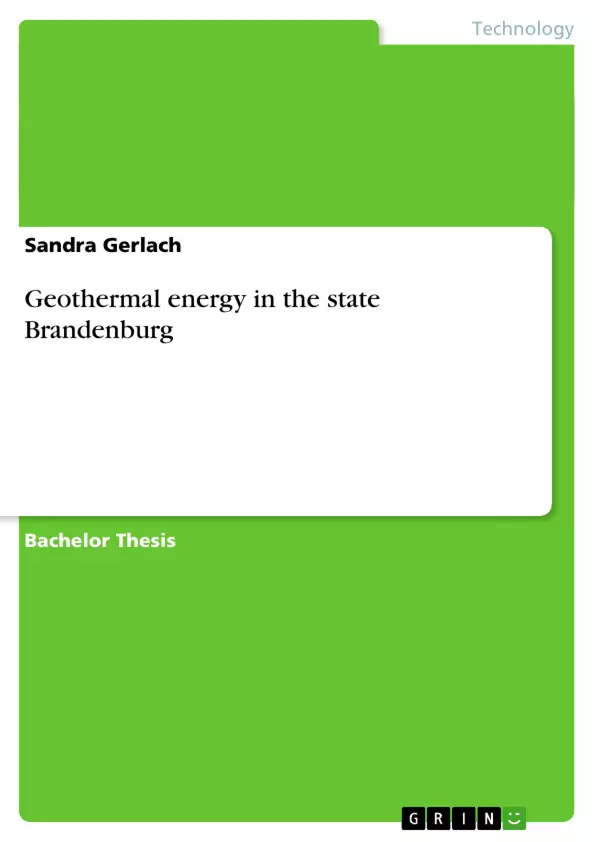Worldwide the demand in energy is increasing continuously. The awareness that fossil energy resources are limited and the fluctuation of crude oil- and natural gas prices were leading internationally and nationally to the recognition of geothermal energy as a possible energy source among the renewable energies (Rummel et al., 1993).
Geothermal energy is the heat of the earth. According to technical applications geothermal energy can be classified into three different natural systems, the shallow geothermal system, the hydrothermal low or high pressure systems and the hot dry rock system. These three systems of geothermal energy are described according to their possibilities of technical application. Legal requirements are playing a significant role in the application of geothermal energy as well as the political situation with regard to energy politics in the different states of Germany.
Special attention is given to the state Brandenburg. At first the geologic conditions have to be outlined. From the geologic conditions and the energy political situation as well as the supply and demand structure in Brandenburg, the potential for the use of geothermal energy is arising. Applications of geothermal energy started in the beginning of the 20th century in Brandenburg are in form of thermal springs. In the second half of the 20th century the use in Brandenburg turned to the utilization of shallow geothermal energy and later to deep geothermal energy projects. Today mainly the shallow geothermal energy systems are used commercially because they are economically wise in contrast to deep geothermal energy systems which can not be used economically wise yet. Their technology is still under development. Current projects will show their stage of development.
Inhaltsverzeichnis (Table of Contents)
- Acknowledgement/ Affidavit,
- Abstract
- Table of contents
- 1. Introduction
- 1.1. Use of natural heat of the earth until today.
- 1.2. Definition of geothermal energy.
- 2. Main features of geothermal energy
- 2.1. The different types of geothermal energy sources.
- 2.2. Technology of geothermal energy and technological problems in connection with possible ecological effects_
- 2.2.1. Hydrothermal energy technology.
- 2.2.2. Hot dry rock method
- 2.2.3. Shallow geothermal application systems..
- 2.3. Legal and political aspects__
- 2.3.1. Legal requirements_
- 2.3.2. Energy political measures
- 3. Geothermal energy in Brandenburg
- 3.1. Geology of Brandenburg
- 3.1.1. Character of the landscape.
- 3.1.2. Present day climatic condition
- 3.1.3. Geological and hydrological overview of Brandenburg.
- 3.1.4. Relations between tectonic structure and temperature distribution in Brandenburg
- 3.1.5. The temperature distribution in Brandenburg
- 3.1.6. Chemical composition of thermal water in Brandenburg.
- 3.2. Geothermal potential of Brandenburg...
Zielsetzung und Themenschwerpunkte (Objectives and Key Themes)
This Bachelor Thesis explores the potential of geothermal energy in the state of Brandenburg, Germany. It investigates the various technologies employed for geothermal energy utilization, analyzes the geological conditions of Brandenburg, and examines the legal and political framework surrounding geothermal energy development in the region.
- Exploration of different geothermal energy technologies and their applications
- Assessment of the geological and hydrological conditions in Brandenburg
- Analysis of the legal and political framework governing geothermal energy use in Germany
- Evaluation of the potential for utilizing geothermal energy in Brandenburg
- Discussion of the current state of geothermal energy projects in Brandenburg
Zusammenfassung der Kapitel (Chapter Summaries)
- Chapter 1: Introduction This chapter provides an overview of the historical use of geothermal energy and defines the term "geothermal energy." It discusses the increasing demand for energy worldwide and highlights the importance of exploring alternative energy sources like geothermal energy.
- Chapter 2: Main Features of Geothermal Energy This chapter delves into the different types of geothermal energy sources, including hydrothermal energy, hot dry rock systems, and shallow geothermal systems. It examines the technologies associated with these sources, highlighting potential ecological impacts and addressing legal and political considerations.
- Chapter 3: Geothermal Energy in Brandenburg This chapter focuses specifically on Brandenburg, outlining its geological characteristics, including its landscape, climate, and hydrological features. It explores the relationship between tectonic structures and temperature distribution, examining the temperature profile and chemical composition of thermal water in the region.
Schlüsselwörter (Keywords)
This thesis focuses on geothermal energy, its potential applications in Germany, and its specific relevance to the state of Brandenburg. It examines the various technologies employed for geothermal energy utilization, explores the geological conditions of Brandenburg, and analyzes the legal and political frameworks surrounding geothermal energy development. Key terms and concepts include geothermal energy technologies, geological features, legal and political regulations, and the potential for geothermal energy utilization in Brandenburg.
- Quote paper
- M.Sc. Sandra Gerlach (Author), 2004, Geothermal energy in the state Brandenburg, Munich, GRIN Verlag, https://www.grin.com/document/25376



